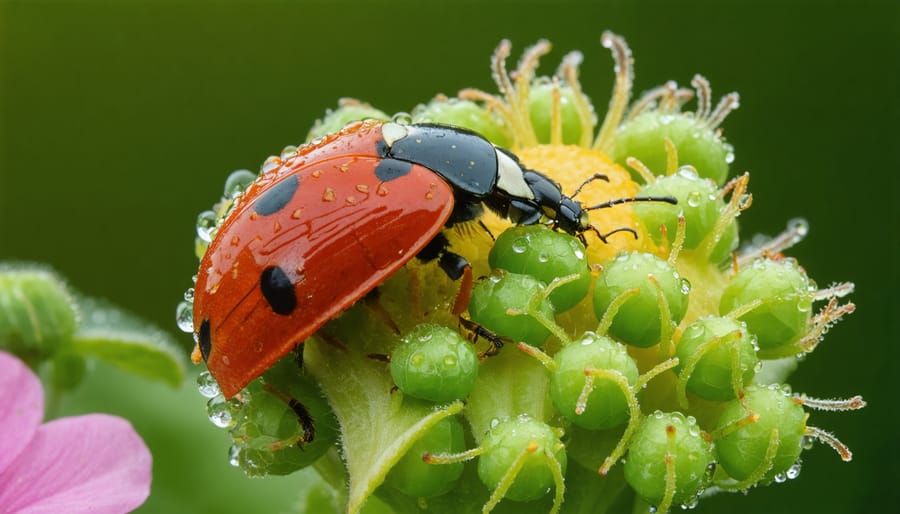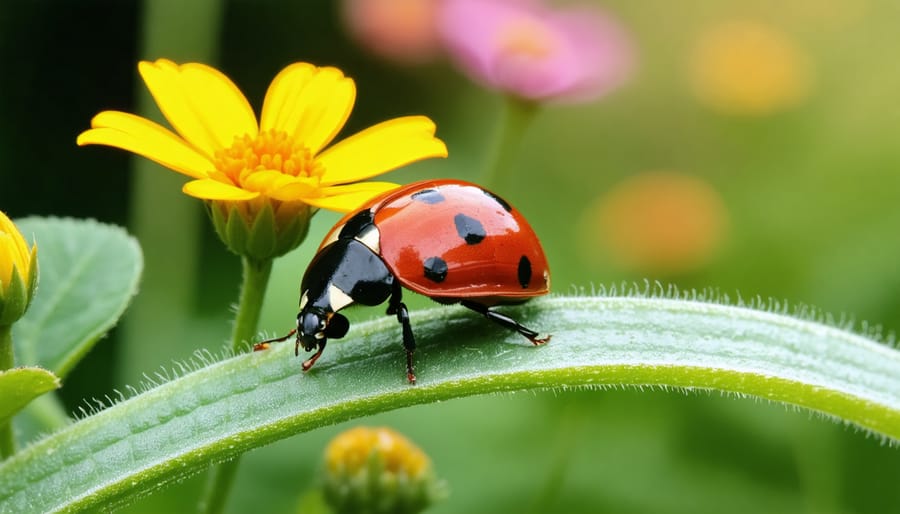Transform your garden’s pest control strategy naturally with botanical insecticides, nature’s own defense against harmful insects. These plant-derived eco-friendly pesticides harness the power of essential oils, compounds, and extracts that plants have evolved over millions of years to protect themselves from pests.
Unlike synthetic chemicals, botanical insecticides break down rapidly in sunlight and soil, leaving no harmful residues while effectively managing garden pests. From neem oil’s broad-spectrum effectiveness to pyrethrum’s quick action against flying insects, these natural solutions work in harmony with your garden’s ecosystem, protecting beneficial insects and pollinators.
Modern gardeners increasingly turn to these time-tested solutions, combining ancient wisdom with scientific validation. Whether you’re tending to precious heirloom tomatoes or nurturing delicate herbs, botanical insecticides offer a safe, sustainable path to garden health that aligns with nature’s own pest management strategies.
Note: This concise, action-oriented introduction addresses the target audience’s needs while maintaining an accessible, encouraging tone and incorporating the required internal link naturally within the flow of information.
What Are Botanical Insecticides?
Common Plant-Based Sources
Nature provides us with several effective plant-based insecticides that have been used for generations. Neem, derived from the neem tree, is perhaps the most versatile, offering broad-spectrum pest control while being gentle on beneficial insects. Its active compound, azadirachtin, disrupts pest feeding and growth patterns.
Pyrethrum, extracted from chrysanthemum flowers, delivers quick knockdown action against various garden pests. It’s particularly effective against aphids, beetles, and caterpillars. Many gardeners love growing their own chrysanthemums not just for their beauty, but also for their natural pest-fighting properties.
Other powerful botanical defenders include garlic, which acts as both an insecticide and fungicide, and hot peppers, which create a natural deterrent that most insects avoid. Rotenone, sourced from certain tropical legumes, is another traditional option, though it should be used sparingly.
Marigolds and lavender serve double duty in the garden – they’re beautiful flowering plants that naturally repel many common pests. Not only do these plants help protect your garden, but they also add wonderful color and fragrance to your growing space.

How They Work
Botanical insecticides work through several fascinating mechanisms to protect your plants from unwanted pests. Unlike synthetic pesticides, these natural alternatives often employ multiple strategies simultaneously, making them highly effective garden allies.
Many botanical insecticides act as feeding deterrents, making your plants less appetizing to insects. For example, neem oil creates an unpalatable coating on leaves that discourages pests from taking a bite. Others, like pyrethrum (derived from chrysanthemum flowers), affect the insect’s nervous system, causing them to stop feeding and eventually leave the area.
Some botanical solutions work by interfering with pest growth and development. Neem oil, in particular, disrupts hormone production in insects, preventing larvae from developing properly and reducing future pest populations naturally. Rotenone, extracted from certain tropical plants, works by disrupting cellular respiration in insects while remaining relatively harmless to plants.
Physical barriers are another common mechanism. Essential oils and other plant extracts create protective films on plant surfaces that make it difficult for insects to move or lay eggs. These natural compounds can also block insects’ breathing pores, though this effect is usually temporary and needs regular reapplication.
What makes botanical insecticides especially garden-friendly is their tendency to break down quickly in sunlight and soil, leaving no harmful residues behind while still getting the job done.
Benefits of Using Botanical Insecticides
Environmental Impact
One of the most compelling advantages of botanical insecticides is their minimal environmental impact. Unlike synthetic pesticides that can linger in the soil for years, botanical alternatives naturally break down through exposure to sunlight, rain, and soil microorganisms. This rapid biodegradability means they don’t accumulate in the environment or create long-term soil contamination.
These plant-based solutions work harmoniously with natural ecosystems. They’re generally less harmful to beneficial insects like bees, ladybugs, and butterflies when used as directed, helping maintain the delicate balance in your garden. Many botanical insecticides also have a shorter residual effect, meaning they dissipate quickly after doing their job, reducing the risk to wildlife and pets.
Additionally, because botanical insecticides are derived from renewable plant sources, their production typically has a smaller carbon footprint compared to synthetic alternatives. They require less energy to manufacture and don’t generate harmful byproducts during production. For gardeners committed to environmental stewardship, this makes botanical insecticides an excellent choice for pest management while preserving our planet’s health for future generations.
Safety for Beneficial Insects
While botanical insecticides are effective against harmful pests, they can also impact beneficial insects if not used thoughtfully. To protect these helpful garden allies, timing and targeted application are crucial. Apply botanical sprays early in the morning or late in the evening when pollinators are less active, and always spot-treat affected areas rather than spraying your entire garden.
Choose formulations that break down quickly, like neem oil or pyrethrin, to minimize long-term exposure. Create safe zones in your garden by leaving some areas completely untreated, allowing beneficial insects to thrive and maintain their populations. These refuge areas can include flowering plants that attract natural predators like ladybugs and lacewings.
Remember to inspect plants carefully before treating them and only apply botanical insecticides when pest problems are clearly visible. This selective approach helps maintain the delicate balance in your garden ecosystem, ensuring that helpful insects continue their valuable work of pollination and natural pest control while you manage problematic insects effectively.

Making Your Own Botanical Insecticides
Basic Recipes
Creating effective homemade pest control solutions from garden plants is simpler than you might think. Here are three reliable recipes to get you started:
Garlic and Chili Spray
Blend 6 cloves of garlic and 2 hot chilies with 2 cups of water. Let the mixture steep overnight, strain, and add a few drops of liquid soap. Dilute with water at a 1:4 ratio before spraying on affected plants.
Neem Leaf Extract
Soak 2 cups of crushed neem leaves in 4 cups of water overnight. Strain the mixture and add a teaspoon of liquid soap. This solution works wonderfully against soft-bodied insects and fungal issues.
Marigold Tea Spray
Steep 2 cups of fresh marigold flowers in 4 cups of boiling water for 30 minutes. Once cooled, strain and spray directly on plants. The natural compounds in marigolds help deter various garden pests while being gentle on beneficial insects.
Remember to test these solutions on a small area first and apply during early morning or evening hours for best results.

Application Tips and Best Practices
The key to success with botanical insecticides lies in proper timing and application methods. As part of an integrated pest management approach, these natural solutions work best when applied strategically.
Always apply botanical insecticides during the early morning or late evening when beneficial insects are less active and temperatures are cooler. This timing helps protect friendly garden helpers like bees and ladybugs while maximizing the effectiveness of your treatment.
Before applying any botanical solution, thoroughly inspect your plants to identify the affected areas. Mix your botanical insecticide according to package instructions – remember, more isn’t always better! Use a fine mist sprayer to ensure even coverage, paying special attention to the undersides of leaves where pests often hide.
For best results, apply botanical insecticides when pest populations are still relatively small. Most natural solutions work through direct contact, so complete coverage is essential. Reapplication may be necessary every 5-7 days, as botanical insecticides break down more quickly than synthetic alternatives – that’s what makes them eco-friendly!
Weather conditions matter too. Choose a calm day to prevent spray drift, and avoid application just before rain is expected. If rain occurs within 24 hours of treatment, you’ll likely need to reapply.
Remember to wear appropriate protective gear, even though these are natural products. Long sleeves, gloves, and eye protection are recommended. Keep children and pets away from treated areas until the spray has dried completely.
Store your botanical insecticides in a cool, dark place to maintain their effectiveness, and always label containers clearly with mixing ratios and application dates.
Botanical insecticides offer gardeners a natural and effective way to protect their plants while maintaining harmony with the environment. By choosing these plant-based alternatives, we’re not only safeguarding our gardens but also contributing to the broader ecosystem’s health. Remember that successful pest management isn’t about eliminating all insects – it’s about creating a balanced garden where beneficial insects thrive and pest populations remain in check.
As you embark on your botanical insecticide journey, start small and observe how your garden responds. Combine these natural solutions with other sustainable practices like companion planting, crop rotation, and maintaining healthy soil. Keep a garden journal to track what works best in your specific environment, and don’t be afraid to adjust your approach as needed.
The future of gardening lies in these eco-friendly methods that our ancestors once used and modern science continues to validate. Whether you’re a seasoned gardener or just starting, incorporating botanical insecticides into your pest management strategy is a step toward more sustainable and rewarding gardening. Your garden – and the planet – will thank you for making this natural choice.




